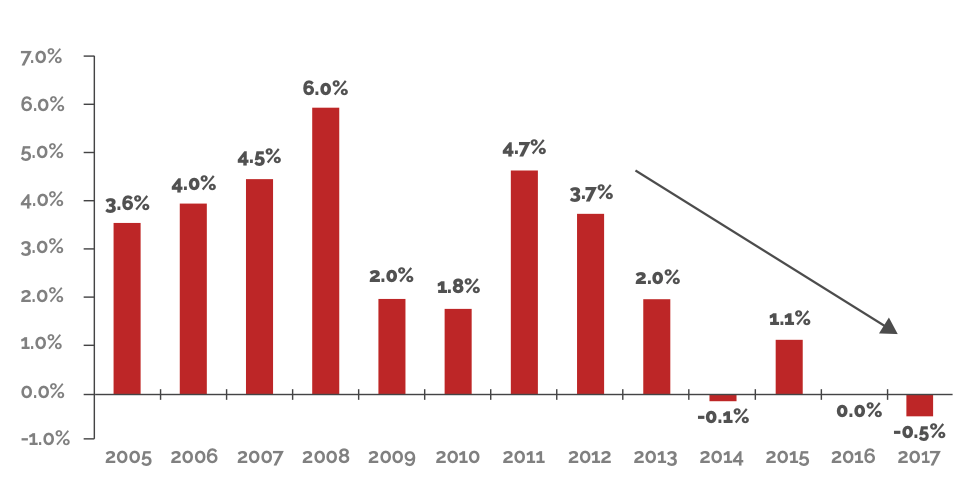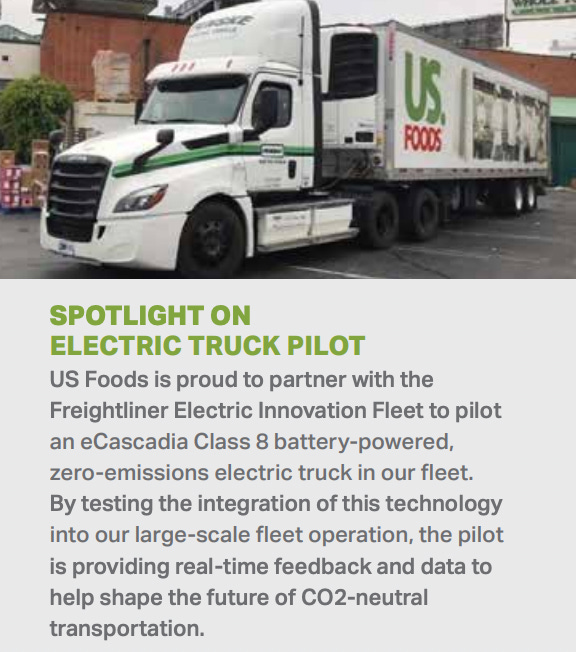Is Big Food The Problem? Or The Solution?
The Big Food (5th) Edition of the Negative Foods Newsletter
Criticizing Big Food is irresistible. And it’s not just me. And you. Consumer demand also criticizes. If we exclude sales from acquisitions, Big Food revenue growth has been tanking for more than a decade.
And for good reason. Consumers increasingly connect food consumption with health, which bodes poorly for the Big Food legacy portfolios of ultra-processed and sugar-sweetened foods & beverages.
You and we also love to criticize big companies for greenwashing. Combine these two dart-throwing activities with the recent rash of Big Food regenerative agriculture announcements, and Mount Skepticism explosively erupts.
Should we give Big Food a regenerative chance? First, consider some of the announcements:
General Mills. General Mills' Epic debuts bar with beef raised through regenerative farming.
Danone. Horizon Organic [part of Danone] committed to being carbon-positive across its supply chain by 2025. The company said in an announcement it would be the first national dairy brand to achieve this status. The (then) CEO of Danone North America said in a release that time is up to do something about climate change, and food and farming must evolve. "This includes helping our farmer partners implement breakthrough regenerative soil practices, cow feed and diet management programs, and energy efficiency.”
Mondelez. Mondelez's SnackFutures innovation hub debuted NoCoé, said to be the first carbon-neutral snack brand.
Maple Leaf Foods. In 2019, Maple Leaf announced it was the first major food company to become carbon neutral.
Nestle. Nestle’s carbon footprint is 2x Switzerland and it has committed to reach net zero by 2050. Benjamin Ware, head of Sustainable Sourcing and Climate Diversity, said “We will achieve this through carbon reductions and removals … and not so much through the use of offsets and carbon credits.”
Land O’Lakes. Land O’Lakes has partnered with Microsoft to help dairy farms adopt regenerative practices. “The new alliance will develop capabilities to quickly and effectively predict the carbon benefits of regenerative practices like no-till, precision nutrient management and planting of cover crops. Combining such capabilities with the real-time transparency from remote sensing and satellite data will make certification of these projects in global carbon markets easier, quicker and less expensive — ultimately maximizing the economic value for farmers.“
Stonyfield. Stonyfield, an OG sustainability pioneer, is planning to make farms a lever to reverse climate change.
Should we trust the announcements of Big Food? Remember when the PepsiCo CEO said that Tropicana is “good for you”**. That’s wan’t true then, it isn’t true now, and those sorts of statements are unfortunately a pattern that continues. So don’t lose your skepticism.
But don’t be cynical. And don’t sit still. Remember that the disruptors (like you) force the big companies to pay attention and shift course. I don’t think General Motors would have announced an all electric future if Tesla hadn’t changed the world first. We will see similar changes in the GMs of the food industry when they respond to the Teslas of the food industry.
At the same, don’t forget that we have to change the world starting with how it actually is (not how we wish it was). I welcome GM’s foray into electric cars. And I welcome Big Food into the regenerative agriculture movement. And that’s going to be necessary for several reasons:
Scale and Time. To avert climate catastrophe, we have to eliminate emissions from the food system, and we have to do so quickly, and we have to do it in a way that will continue to feed hundreds of millions of Americans. Rebuilding our national food systems would take decades, consume hundreds of billions of dollars and emit significant greenhouse gasses. Imagine how much easier it will be to finance and complete the conversion of U.S. Food’s fleet of trucks to zero emissions trucks as compared to creating the fleets of hundreds of small startup distributors. We can’t start over. We need the existing major players to play crucial roles in eliminating emissions from our supply chains.
Let Good People Do Good. Big does not equal bad. Big and bad is really bad, and big and good is really good. And there are some large companies doing good work on these matters. Consider Nick Bertram, the President & CEO of The Giant Company, a powerhouse division of Ahold Delhaize, one of the world’s largest food retailers. Giant has partnered with The Rodale Institute to support regenerative agricultural practices. This is a great example of a big food company doing good work for good reasons. And I’m not accusing Giant of altruism. Thoughtful food companies recognize that consumers and investors care about carbon footprints, and that leading the way will be better for future revenues, future customer loyalty, future stock prices, and maintaining a future work force that cares about the planet. Giant isn’t the only example. You’ll find great climate leaders at many Big Food companies. Some of them mean to do good, and will, and we should support them.
Follow the Money. My (awesome) 15yo daughter Amelia already knows that, if you can’t figure something out, follow the money. Even with (expected) strong consumer demand, the U.S. will need a lot of money to finance the Teslas of the food industry. This money will come in large part from venture capital and growth private equity firms, and their returns will be based on Big Food acquiring their startups. And this is all good IMO. What’s past is prologue. As they responded to consumer demand for healthier foods, Big Food had to acquire market share. Examples include Coca Cola acquiring healthier beverage brands, PepsiCo acquiring Casey Emmett’s Health Warrior, General Mills acquiring organic snack powerhouse Annie’s and bread behemoth Flowers acquiring Dave’s Killer Bread (my kids’ favorite bread brand). We’ll see this movie again with carbon negative food. Big Food always struggles to realize their innovation ambitions because internal R&D is hard, and cannibalizing legacy brands is even harder. And so they acquire startups. This is what the U.S. does best, and it is a healthy part of how the food system evolves. Let’s try to accelerate this evolution.
So I think we should give them a chance. AND I think we should pressure them with great startups that will eat their lunches if they don’t change fast enough. If you think I’m wrong, share your feedback!
Your Feedback. So much feedback from the Kelp Edition of the Negative Foods Newsletter!
Tony Ambrose, my favorite chef in Boston, points out that he’s been using kelp since 1993, in everything from bread to sauce infusions. I miss Ambrosia, and I’m grateful this newsletter got me back in touch with Tony!
My old friend Russell Pullan chimed in: “I lived for two years in Japan during my salad days (pun intended) and learned to love seaweed; they say it's good for hair and skin.“
AgFunder Partner Rob Leclerc: “There’s also a company called Phykos that wants to automate the farming of kelp for carbon sequestration.”
Venture Capitalist Sarah Cone tells me that eelgrass is the next big thing!
Koen van Seijen of the Investing in Regenerative Agriculture podcast correctly points out that “Kelp is always the answer.”
What’s your feedback on the Big Food edition of the newsletter? Let me know!
Product Review: The Mussels at Le Jardin du Roi in Chappaqua NY
I’ve still got the fruits of the sea on the brain. While harvesting kelp in Maine last week, I learned that kelp grows symbiotically with other creatures that are good for the sea and the planet, such as oysters and mussels. During a dinner on Sunday night at one of our favorite local restaurants, we therefore especially enjoyed the mussels (with a garlic, shallots and white wine sauce), pondering their positive impact.
From Yale Climate Connections: “You have your strings of mussels that are growing alongside your strings of kelp. Not only does it help in terms of [ocean] acidification, but it provides a little bit of a carbon sink and sequesters some of the local carbon, tempers the surrounding acidity, and also just overall produces a better shellfish product,” Parks says. The kelp create oxygen pockets which the bivalves thrive in, but also draw out some of the excess carbon in the ocean, which helps mitigate the effects of climate change.”
For Your Consideration:
How One Tech Entrepreneur (ahem…) is Rethinking SALAD
Food: A Circular Economy Investment Opportunity For Companies
Can regenerative agriculture reverse climate change? Big Food is banking on it
HBR: The Climate-Equity Connection (Two trends will force business into action)
Danone is working to develop and promote regenerative models of agriculture
Kenya’s Dryland Farmers Embrace Regenerative Farming to Brave Tough Climate
New Farmers Union Climate Panel Gives Diverse Group of Farmers and Ranchers a Seat at the Table
* Credit Suisse estimates; includes CPB, CAG, GIS, NHZ, HSY, K, KHC, MDLZ, MKC & SJM.
** Remember that food sales are based on consumer demand (not CEO spin). Americans Don’t Want Orange Juice, and for the right reasons.





A fantastic piece, Paul! Really got me thinking differently about the consolidation power of big ag, and how it can be for good. I do wonder if we are about to enter an era of ‘small’ or micro production of goods. Local economies have scaled many of the convenience options that only big corporations could deliver, and small batch goods are now a significant trend. My most common consumer feedback is that they want to ‘know who grows their food’ and no matter what, big ag can’t do that. I think our next era is Local communities wanting to be self reliant and have diverse economies. I have to say I’m not totally convinced that tons of small producers with their own small scale distribution capabilities, can’t be more efficient than an electrified US foods but I look forward to reading more about it! Lots of research to be done after provoking great thought. Thanks Paul.